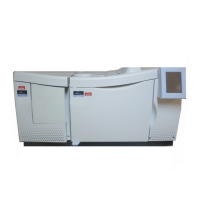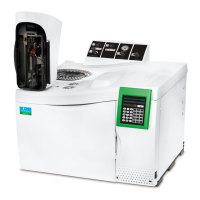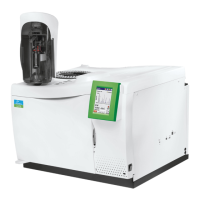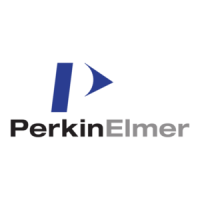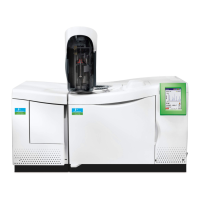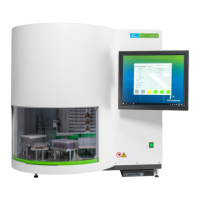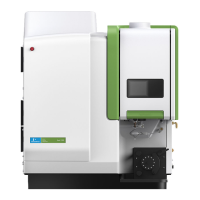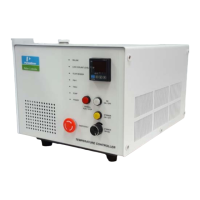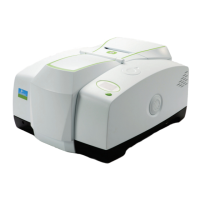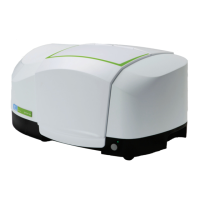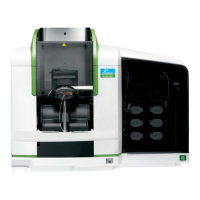Do you have a question about the PerkinElmer CLARUS 590 GC and is the answer not in the manual?
Provides a brief introduction to the instrument, conventions, and warnings.
Lists and defines abbreviations used on the Clarus GC screens.
Defines terms related to Clarus GC, including autosampler and instrument-specific terms.
Provides an overview of touch screen navigation and definitions.
Describes the main display area, entry fields, buttons, and status indicators.
Explains the Run button functionality for autosampler and manual injections.
Details the Signal button, Ignite, AutoZero, and Signal Plot features.
Describes how to access and interact with injector and detector settings.
Explains the navigation bar for toggling between channels and accessing system areas.
Covers configuration options for injectors like PSSI, including temperature programs.
Details setting carrier gas pressure, flow, or velocity programs for injectors.
Provides instructions for configuring packed and programmable on-column injectors.
Describes how to set up oven temperature programs.
Explains the process for single point calibration of the oven temperature.
Explains how to configure and manage auxiliary zones for temperature control.
Covers FID overview, auto-ignition, and manual ignition procedures.
Details ECD overview, setup, regulations, and troubleshooting.
Explains TCD overview, setup, bridge balancing, and current settings.
Covers PID overview, lamp intensity optimization, and make-up gas adjustment.
Details NPD overview, bead activation, and gas flow settings.
Explains FPD overview, linearizer, temperature, and gas flow setup.
Covers displaying, changing detector temperatures and setting detector ranges.
Describes how to enable and use the autozero function for detectors.
Explains how to use the Events tab, add, edit, delete, and clear timed events.
Details settings for relays and auxiliary zones through timed events.
Covers accessing and using the Method Editor for method management.
Explains how to save, open, activate, and delete methods.
Provides guidance on modifying active method parameters for analysis.
Details setting up temperature programs for ovens and injectors.
Covers viewing and setting carrier gas pressure, flow, and velocity.
Explains how to set septum purge mode and split vent flow.
Details setting up splitless injection modes, including pulse techniques.
Accessing Method Editor and Event Log through the Tools menu.
Covers maintenance reminders and accessing GC configuration settings.
Explains deconfiguring and configuring injectors like Packed, POC, PSS, and Capillary.
Details connecting and configuring PPC modules for injectors and detectors.
Provides steps for zeroing and calibrating PPC gas and detector modules.
Guides through calibrating carrier gas modules for different gases.
Describes how to place the thermometer probe correctly in the oven.
Explains how to equilibrate the oven temperature for accurate calibration.
Details how to enter the offset value after temperature stabilization.
Calculates capillary column gas flow rates and related parameters.
Describes the stopwatch function and accessing oven program rate data.
Navigating the System Status screen and setting oven temperatures.
Covers setting up packed and PSS injectors, including temperature and carrier gas.
Details setting up FID and TCD detectors, including gas flows and timed events.
Explains how to configure and run the autosampler for analyses.
| Type | Gas Chromatograph |
|---|---|
| Column Type | Capillary |
| Oven Temperature Range | Ambient +5°C to 450°C |
| Maximum Heating Rate | 120°C/min |
| Maximum Number of Methods | Unlimited |
| Detector Type | FID, TCD, ECD |
| Injector Options | Split/Splitless, PTV, On-column |
| Gas Control | Electronic Pressure Control (EPC) |
| Temperature Programming Rates | Up to 120°C/min |
| Carrier Gas Control | Electronic pressure control (EPC) |
| Dimensions (W x D x H) | 24 x 29 x 20 in |
| Power Requirements | 100 V, 120 V, 220 V, 230 V, 240 V; 50/60 Hz |
| Data System | TotalChrom CDS |
